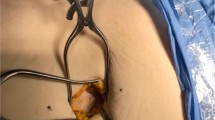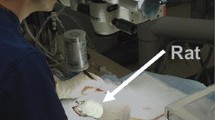Abstract
Background
Considerable training is necessary to master laparoscopic suturing and knot-tying. Robotic systems are assumed to facilitate these skills and shorten the learning curve. The effect of laparoscopic experience and robotic assistance on the learning curve of vascular anastomoses was studied.
Methods
A laparoscopically experienced surgeon and a laparoscopically inexperienced surgeon made alternating laparoscopic vascular anastomoses and robot-assisted laparoscopic vascular anastomoses using a Zeus–Aesop surgical robotic system with various prosthetic conduits and suture materials in a laparoscopic training box.
Results
Neither laparoscopic method influenced the quality score or leakage rate, but with laparoscopic experience, significantly fewer failures were made. Suturing and knot-tying were faster with laparoscopic experience both with and without the robotic system, and fewer stitch actions and knot actions were performed. The learning curves of both surgeons were not improved by the robotic system.
Conclusions
Experience is the most important factor in the performance of laparoscopic vascular anastomoses. The robotic system was not helpful in shortening the learning curve.


Similar content being viewed by others
References
Alimi YS, Di Molfetta L, Hartung O, Dhanis A, Barthelemy P, Aissi K, Giorgi R, Juhan C (2003) Laparoscopy-assisted abdominal aortic aneurysm endoaneurysmorrhaphy: early and midterm results. J Vasc Surg 37: 744–749
Barbera L, Damiano RJ Jr, Tabaie HA, Mack MJ, Edgerton JR, Mullangi C, Graper WP, Prasad SM (2001) Initial prospective multicenter clinical trial of robotically assisted coronary artery bypass grafting. Ann Thorac Surg 72: 1263–1268
Barbera L, Mumme A, Metin S, Zumtobel, V, Kemen, M (1998) Operative results and outcome of 24 totally laparoscopic vascular procedures for aortoiliac occlusive disease. J Vasc Surg 28: 136–142
Cadiere GB, Himpens J, Germay O, Izizaw R, Degueldre M, Vandromme J, Capelluto E, Bruyns J (2001) Feasibility of robotic laparoscopic surgery: 146 cases. World J Surg 25: 1467–1477
Castronuovo JJ Jr, James KV, Resnikoff M, McLean ER, Edoga JK (2000) Laparoscopic-assisted abdominal aortic aneurysmectomy. J Vasc Surg 32: 224–233
Den Boer KT, Straatsburg IH, Schellinger AV, de Wit LTh, Dankelman J, Gouma DJ (1999) Quantitative analysis of the functionality and efficiency of three surgical dissection techniques: a time-motion analysis. J Lap Endosc Adv Surg Tech 9: 389–395
Dion YM, Boyd WD, Desai ND, Kiaii B, Rayman R, Menkis AH, McKenzie FN, Novick RJ. (2000) A comparison of robot-assisted versus manually constructed endoscopic coronary anastomosis. Ann Thorac Surg 70: 398–428
Dion YM, Gracia CR, Estakhri M Demalsy JC, Douville Y, Piccinini E, Stancanelli V (1998) Totally laparoscopic aortobifemoral bypass: a review of 10 cases. Surg Laparosc Endosc 8: 165–170
Hanna GB, Drew T, Clinch P, Hunter B, Cuschieri A (1998) Computer-controlled endoscopic performance assessment system. Surg Endosc 2: 997–1000
Kline RG, D’Angelo AJ, Chen MH, Halpern VJ, Cohen JR (1998) Laparoscopically assisted abdominal aortic aneurysm repair: first 20 cases. J Vasc Surg 27: 81–87
Kolvenbach R, Schwierz E, Wasilljew S, Miloud A, Puerschel A, Pinter L (2004) Total laparoscopically and robotically assisted aortic aneurysm surgery: a critical evaluation. J Vasc Surg 39: 771–776
Marusch F, Gastinger I, Schneider C, Scheidbach H, Konradt J, Bruch HP, Kohler L, Barlehner E, Kockerling F, Laparoscopic Colorectal Surgery Study Group (LCSSG) (2001) Experience as a factor influencing the indications for laparoscopic colorectal surgery and the results. Surg Endosc 15: 116–120
Melvin WS, Needleman BJ, Krause KR, Schneider C, Ellison EC (2002) Computer-enhanced vs standard laparoscopic antireflux surgery. J Gastrointest Surg 6: 11–15
Nio D, Balm R, Maartense S, Guijt M, Bemelman WA (2004) The efficacy of robot-assisted versus conventional laparoscopic vascular anastomoses in an experimental model. Eur J Vasc Endovasc Surg 27: 283–286
Nio D, Bemelman WA, den Boer KT, Dunker MS, Gouma DJ, Gulik TM (2002) Efficiency of manual versus robotical (Zeus) assisted laparoscopic surgery in the performance of standardized tasks. Surg Endosc 16: 412
Prasad SM, Maniar HS, Soper HJ, Damiano RJ, Klingensmith ME (2002) The effect of robotic assistance on learning curves for basic laparoscopic skills. Am J Surg 183: 702–707
Ruurda JP, Wisselink W, Cuesta MA, Verhagen HJM, Breeders IAMJ (2004) Robot-assisted versus standard videoscopic aortic replacement: a comparative study in pigs. Eur J Vasc Endovasc Surg 27: 501–506
Smith DC, Farrell TM, McNatt SS, Metreveli RE (2001) Assessing laparoscopic manipulative skills. Am J Surg 181: 547–550
Smith SG, Torkington J, Brown TJ, Taffinder NJ, Darzi A (2002) Motion analysis. Surg Endosc 16: 640–645
Watson DI, Baigrie RJ, Jamieson GG (1996) A learning curve for laparoscopic fundoplication: definable, avoidable, waste of time? Ann Surg 224: 198–203
Wisselink W, Cuesta MA, Gracia C, Rauwerda JA (2002) Robot-assisted laparoscopic aortobifemoral bypass for aortoiliac occlusive disease: a report of two cases. J Vasc Surg 36: 1079–1082
Yohannes P, Rotariu P, Pinto P, Smith AD, Lee BR (2002) Comparison of robotic versus laparoscopic skills: is there a difference in the learning curve? Urology 60: 39–45
Author information
Authors and Affiliations
Corresponding author
Rights and permissions
About this article
Cite this article
Nio, D., Bemelman, W.A., Balm, R. et al. Laparoscopic vascular anastomoses: does robotic (Zeus–Aesop) assistance help to overcome the learning curve?. Surg Endosc 19, 1071–1076 (2005). https://doi.org/10.1007/s00464-004-2178-3
Received:
Accepted:
Published:
Issue Date:
DOI: https://doi.org/10.1007/s00464-004-2178-3




